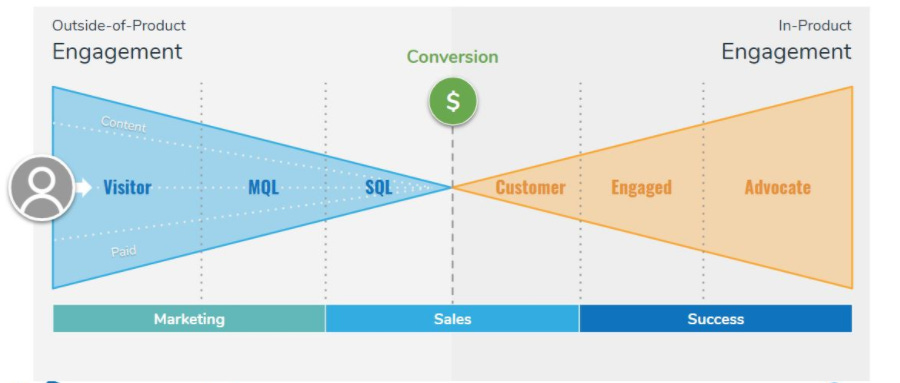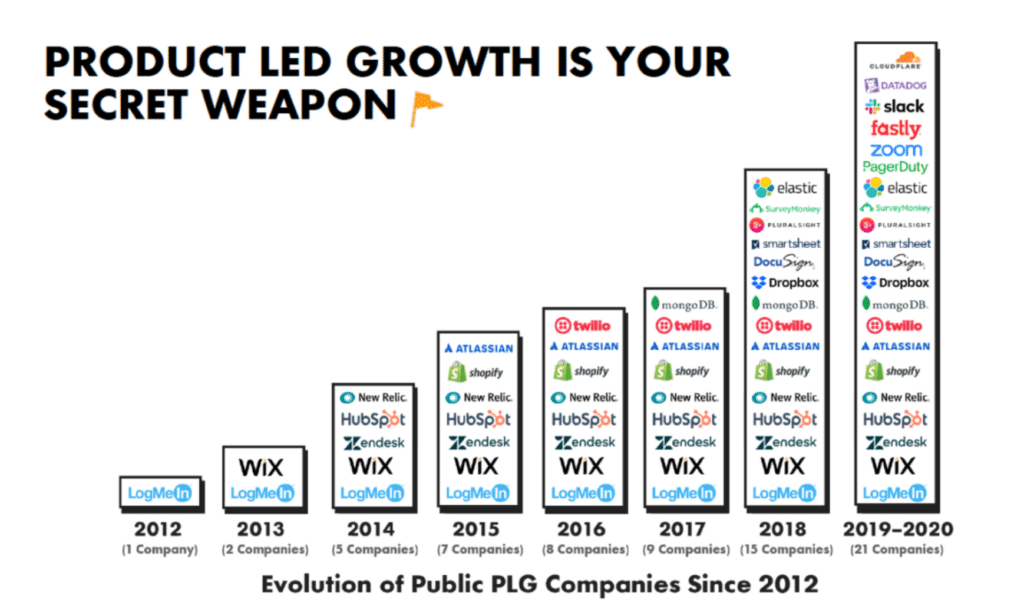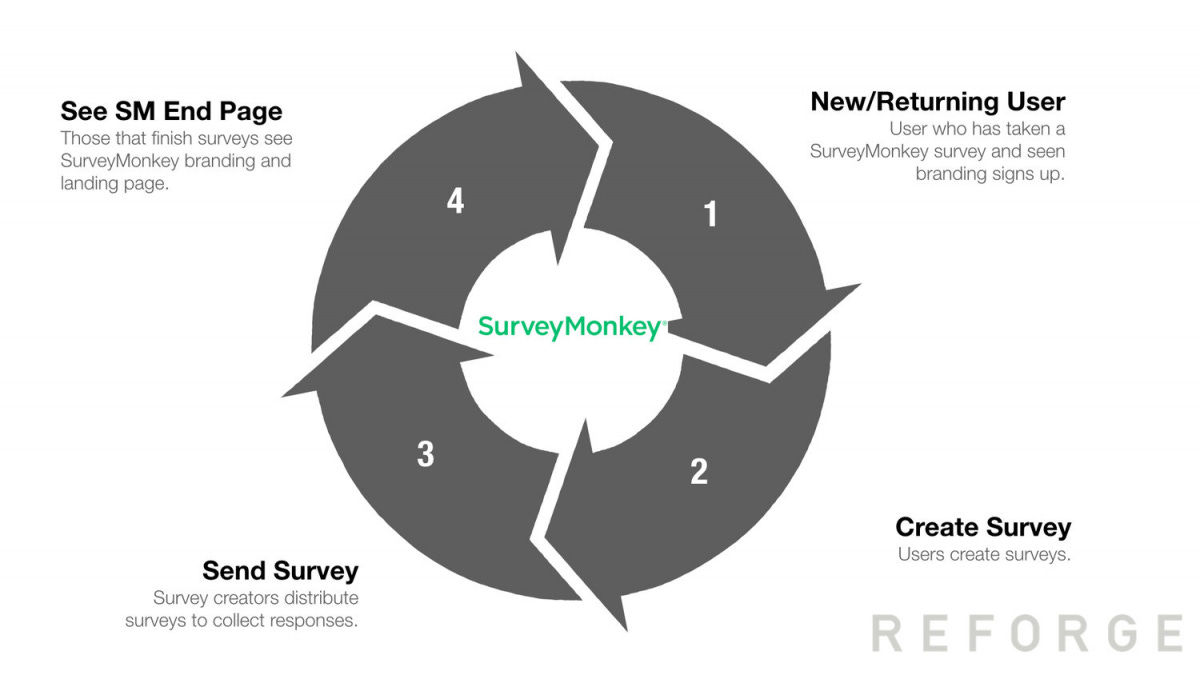A primer on product-led growth
Sales-led and marketing-led had their time. The future is product-led growth.
Introduction
Over the last couple of decades, the industry has seen a paradigm shift in the way customers expect to use and buy any software. Today, customers not only want to get the job done but expect a great experience out of any product they use. Consumer-grade UX, personalization, self-learning modules, instant gratification, etc., have become the norm for any software - be it consumer or enterprise.
An interesting point to note here is that this change is not just limited to the demand side. A similar striking difference is observed on the supply side as well. With the rapid technological advancement, starting up a new company has become ever easier. And with new companies, there is growing competition in the market, and customers have many more alternatives than before. This gives greater power to the buyers to switch to another product or brand when the former fails to provide an adequate experience.
Along with the growing expectations of having a meaningful experience, there is a change in the way customers want to buy products. Previously, most enterprise sales were driven by dedicated and often siloed marketing and sales teams. Today, customers don’t want to listen to the overpromising sales pitches anymore. They want to have a hands-on experience with the product before they purchase it.
This led to the adoption of a new Go-to-market strategy - The Product Led Growth.
What is Product-led growth?
“Product-led growth (PLG) is a business methodology in which user acquisition, expansion, conversion, and retention are all driven primarily by the product itself. It creates company-wide alignment across teams—from engineering to sales and marketing—around the product as the largest source of sustainable, scalable business growth.”
In other words, Product-Led Growth is a strategy that uses the product as a channel to drive organizational KPIs - such as revenue, engagement, and reach.
Product-led growth is somewhat different from traditional sales-led or marketing-led growth models.
Traditional Model
A B2B company typically uses the content or paid channels to create awareness and attract customers in the Traditional growth model. After some essential qualification, a prospect becomes a Marketing qualified lead(MQL), then the lead eventually gets handed over to the sales team. The sales team then nurtures the prospects (and it becomes a sales qualifying lead or SQL) and leads them through the sales funnel. Only after the conversion or purchase, the customer starts to experience the value.
Product-Led Growth model
In the product-led growth model, customers get a personalized experience of the product early in the buying cycle via trials or freemium models. Here, the product teams are responsible for the entire customer journey starting from onboarding to churn. The time it takes for the customers to realize the value since they signed up is called the PQL or product qualified growth.
Product-led growth has seen some significant adoption over the past decade. Successful companies like Airtable, Slack, Figma, Pinterest, Typeform, Warby Parker, Twilio, Expensify, Atlassian, InVision, Zapier, Hootsuite, Buffer, etc. have achieved scalable growth by adopting product-led strategies from day one. Other companies—like HubSpot, for instance—have successfully transitioned from a sales-led to product-led approach.
More specifically, most of these companies take a bottom-up approach by offering consumer-grade experience through a freemium or free-trial offering. Their marketing efforts are primarily centered around building the brand and getting people to try the products themselves rather than trying to drive folks into the arms of a waiting sales rep. And once users are in the product, these companies all offer thoughtful user onboarding experiences and ongoing in-app messaging—essentially embedding sales, customer success, and marketing communications into the product itself.
Frameworks for Product-led growth
Hopefully, by now, we can recognize that the PLG is more than a buzzword. Now, let’s jump in to see a few frameworks that enable companies with product-led growth -
1. Product-Led growth flywheel
The product-led growth flywheel enables businesses to grow by investing in a superior product-led user experience.
In this framework, the experience is designed to generate greater user satisfaction and increased word of mouth, driving compounding growth of new user acquisition.
It depicts four sequential user segments that correlate with stages in the user journey from awareness to evangelism—evaluator, beginner, regular, and champion—and the key actions that users need to take to graduate to the next stage—activate, adopt, adore, and advocate.
The goal is to focus on the company - and team-level strategies by optimizing the user experience to move users from one stage to the next. As the rate of users completing each action increases, the flywheel spins faster, increasing the rate that users move from one segment to the next. This creates a positive feedback loop—as more users become advocates, they drive more acquisition, and growth increases exponentially.
2. Product-Led growth loops
Growth loops are another critical framework that enables companies with PLG. SurveyMonkey is one of the pioneers of using this framework. Let’s see how the SurveyMonkey growth loop allows it for product-led growth.
Let’s say a company, “Company A” wants to run a survey to get user feedback and thus, signs up to SurveyMonkey on the free plan.
Company A crafts their questions, grabs the link, and sends it out to their users. Here, Company A reaps the rewards quickly as they get valuable feedback from their clients.
On the list of users that Company A sent the survey to, Company B fills out the feedback survey. At the end of it, they’re met with the following screen.
That’s how Company B discovers the SurveyMonkey experience and when they need to send out some surveys to their customers, they sign-up for the service.
Now we’re looping. Each customer of SurveyMonkey brings in a percentage of new customers with low effort—who go on to bring in even more customers with minimal effort from SurveyMonkey.
3. The Hook model
The Hook model is another popular framework used for product-led growth. This framework is made popular by Nir Eyal in his book “Hooked.”
“Every habit-forming product addresses some kind of uncomfortable emotional state that we seek to escape from. Our brain is good at pattern matching and this is the heart of it. Lonely? Facebook. Uncertain? Google. Bored? Reddit, YouTube, Pinterest.”
– Nir Eyal, author of "Hooked" and "Indistractable."
The Hook Model, as the name suggests, is designed to hook customers in and form a habit. This habit-forming strategy is made up of four key phases:
Trigger (External or Internal): This is the actuator of behavior. It cues the action that then builds a habit.
Action: Behavior executed in anticipation of the reward.
Variable Reward: The problem that’s solved because of the action taken reinforces the cycle of behavior. Reward types include Rewards of the Tribe (social rewards based on connection and acceptance), Rewards of the Hunt (search for material resources), and Rewards of the Self (personal gratification in the form of mastery or self-realization).
Investment: An action that improves the product or service in the future.
So, how do these work in practice?
Phase 1: The Trigger
A trigger is something that compels users to take some action.
For example, suppose Barbra, a young lady in Pennsylvania, happens to see a photo in her Facebook news feed taken by a family member from a rural part of the state. It’s a lovely photo and since she’s planning a trip there with her brother Johnny, the trigger intrigues her.
Here, the photo in the news feed is an external trigger.
There are usually two types of triggers: external and internal.
An external trigger could be a social ad, a billboard, or even looking out the window and seeing rain clouds then remembering you need to buy an umbrella.
An internal trigger is harder to pin down as it’s an emotion or feeling that your user has—it’s pretty challenging to know when your customer is hungry, bored, or overwhelmed.
Phase 2: The Action
At this point, the user looks to find a solution to her problem or the ‘trigger.’
There are two pulleys of human behavior that companies leverage - motivation and ability. Making the action as easy as possible while simultaneously boosting the user’s motivation is the key to increase the odds of a user taking the intended action.
Using the example of Barbra, with a click on the interesting picture in her newsfeed she’s taken to a website she’s never been to before called Pinterest. Once she’s done the intended action (in this case, clicking on the photo), she’s dazzled by what she sees next.
Phase 3: The Variable Reward
The variable reward is the next phase of the Hook Model. Research shows a surge of dopamine in our body when the brain is expecting a reward. And the variability in rewards multiplies that effect, activating the parts associated with wanting and desire.
Think of a fridge; when you open it every time you see the light is switched on. That may not be compelling enough for you to open the fridge again and again. But, if you see the items in the fridge changes every time you open it, that will trigger the desire within you to open the fridge again and again. The key reason behind this desire is the variability of reward.
When Barbra lands on Pinterest, not only does she see the image she intended to find, but she’s also served a multitude of other glittering objects. The images are associated with what she’s generally interested in – cute farm animals, farmhouse antiques, Pennsylvania landscapes – but there are some others that catch her eye also. The exciting juxtaposition of relevant and irrelevant, tantalizing and plain, beautiful and common sets her brain’s dopamine system aflutter with the promise of reward. Now she’s spending more time on the site, hunting for the next wonderful thing to find. Before she knows it, she’s spent 45 minutes scrolling in search of her next hit.
Phase 4: The Investment
The last phase of the Hook is where the user is asked to invest a bit in the product itself. The investment generally comes in the form of asking the user to give some combination of time, data, effort, social capital, or money.
As Barbra enjoys endlessly scrolling the Pinterest cornucopia, she builds a desire to keep the things that delight her. By collecting items, she’ll be giving the site data about her preferences. Soon she will follow, pin, re-pin, and make other investments, which serve to increase her ties to the site and prime her for future loops through the Hook.
And when the user invests in the product, it becomes even more difficult for them to leave the product or platform.
Conclusion
We learned a whole new Go-to-market strategy - Product-led growth, a growth strategy where the entire user journey is embodied within the product itself. Unlike the sales-led or marketing-led growth models, product-led growth is enabled by the product experience that drives customer adoption, engagement, and growth. It leverages human psychology to enable a greater experience for customers. Product-led growth has made its place in the product community across the globe. If you are interested to learn more about PLG, here are some more resources for you -
Product Led Institute - Dive into PLG
Product-Led Summit - Discover the talks
Wes Bush’s product-led Growth Framework - Watch the webinar
OpenView blog - Check out the blog
Growth design case studies - See the case studies
Hooked: How to Build Habit-Forming Products- See the reviews
Reforge courses and blog - Discover their blog
SaaStr talks on Product and Marketing - View the videos
Good luck with your product-led journey.
Sincerely,
Arkapravo
Reference -
https://www.trychameleon.com/blog/product-led-growth#how-to-implement-a-product-led-growth-strategy
https://www.productled.org/foundations/the-product-led-growth-flywheel
https://productled.com/product-led-growth-strategy-playbook/
That’s all for this article. Thanks for reading. If you wish to read more, please check out the catalog to discover other articles.
I would be delighted to hear your thoughts on this article. Click 👇 to comment.
To receive more such articles in your email, consider subscribing. 👇
Click here to learn more about the Product Hub Newsletter.












Thank you for the insightful blog.Indeed PLG is the way forward